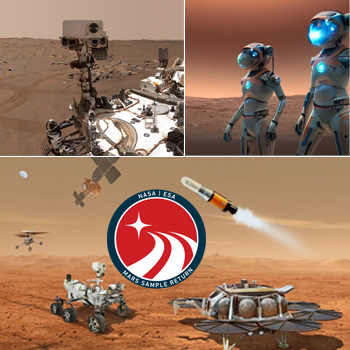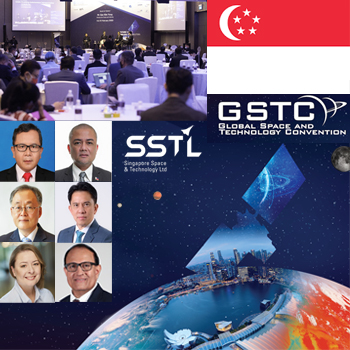Perseverance Rover Entering 3rd Year of Mars Surface Exploration, NASA JPL Education Celebrates Online
|
MONDAY☆ Feb 13 — ISS, ~415-km LEO: Expedition 68 seven-member crew welcoming Progress 83P and commencing cargo transfers, working with Astrobees, Zero T2 device for full body resistance exercise, analyses of water carbon concentration, and crystal growth experiment. ☆ Feb 13 — Tiangong Space Station, ~390-km LEO: Shenzhou 15 three-member crew performing post-EVA activities after mission’s first spacewalk, performing medical checks, continuing space station construction and experiment / cabinet set ups. Highlights… o NewSpace: Construction of Voyager Space Starlab commercial space station advanced by US$80.2M infusion; CLPS providers shift locations for Moon landings – Astrobotic to Gruithuisen Domes NET Q1, and Intuitive Machines targeting South Pole region / Malapert A NET late June. ☆ Solar System: Curiosity analyzing Fe-Ni meteorite ‘Cacao’ with ChemCam laser / spectrometer on Mt Sharp within Mars Gale Crater; CHEOPS space telescope and 10.4-m Gran Telescopio Canarias on La Palma characterize ring of 1,110km-diameter TNO Quaoar at 4,100km, twice Roche limit. ☆ Galaxy: Professional observatory sought to determine origin of apparent emission nebula near M31 in sky discovered by astrophotographers with 4.2-inch Takahashi refractor / Oxygen III filter; newly found exoplanet at 31LY orbiting red dwarf Wolf 1069 may be tidally-locked with potentially habitable areas. o Global: ISRO space science programs to receive 32% less funding in 2023-4 budget, possibly affecting Chandrayaan-3, Aditya L1; Space Telescope Science Institute polling global astronomers on reduction or elimination of data embargo for JWST (1-year) and Hubble telescopes (6-months). ● USA: SpaceX preparing for Starship orbital test in March following successful 31-Raptor engine static firing test of Super Heavy prototype ‘Booster 7’; NASA ISS chief scientist Kirt Costello says station at full utilization, eager for Dream Chaser, HTV-X, Starliner cargo vehicles to become operational. ● Hawai’i: Astronomer Scott Sheppard utilizes Subaru Telescope on Maunakea and Blanco telescope on Cerro Pachón in Chile to discover 12 new moons of Jupiter, half of which will receive names from IAU; USSF working to clean 153m3 of soil contaminated by 2,650-liter diesel fuel leak at Maui Space Surveillance Complex on Haleakalā. |
 |
● = Terrestrial and… o = International terrestrial events
☾ = Moon activity ★ = Space and… ☆ = International space / astro events in Hawaii Standard Time unless noted. Add 10 hours to obtain UT (‘Universal Time’). |
Weekly Planet Watch – Morning Planets: Mercury (E); Evening Planets: Venus (WSW), Mars (S), Jupiter (WSW), Uranus (SW).
SSTL 15th Annual GSTC in Singapore Showcases Latest Space Sector Development
The 2023 Singapore Space and Technology Limited (SSTL) Global Space and Technology Convention (GSTC 2023) themed Future World, Endless Possibilities is being held February 15-16. There will be workshops, CEO roundtable sessions, one-on-one business matching platforms, technologies exhibit and networking areas for participants to share latest space sector industry developments and market trends. There are ~25 exhibiting companies, 37 sponsors and 29 supporting organizations. The guest of honor is (TL-BR) S. Iswaran, Singapore Minister for Transport and Minister-in-charge of Trade Relations; and speakers include Sang-Ryool Lee (KARI), Joel Marciano Jr. (PhilSA), Pakorn Apaphant (GISTDA, Thailand), Aleksandra Bukala (Polish Space Agency), Robertus Heru Triharjanto (ORPA-BRIN, Indonesia) and representatives from UAE Space Agency, Malaysia Space Agency, CNES, UKSA, DLR, Israel Space Agency, OSTIn, Arianespace, Airbus, Dawn Aerospace, BlackSky, Surrey, Maxar, SWF, Planet, Spaceflight, Virgin Orbit, Dhruva Space, Hong Kong Aerospace Technology Group, Kongsberg and Space Forge. On February 10 there was a Singapore Professional Astronomy Workshop, sponsored by ILOA Hawai’i at Science Centre Singapore, bringing together IAU members and astronomy / science PhDs to advance professional astronomy in Singapore. Later this year Singapore will host the 5th Committee on Space Research (COSPAR) Symposium: Space Science with Small Satellites is being planned for April 16-21, followed by 20th Asia Oceania Geosciences Society (AOGS 2023): Surface Science and Exploration of the Moon and Airless Planetary Bodies on July 30 – August 4. (Image Credits: SSTL, NASA) |
o Feb 13-14 — Royal Society, London, United Kingdom: Astronomy from the Moon: The Next Decades; to examine potential uses of the Moon as a platform for astronomical observations and policy implications; free meeting. ☆ Feb 13 — Moon: At last quarter, 06:02. ☆ Feb 13 — Apollo Asteroid 2021 EP4: Near-Earth Flyby (0.048 AU) ☆ Feb 13 — Amor Asteroid 2023 BK2: Near-Earth Flyby (0.083 AU) Continued From… ● Oct 15 – Jun 15, 2023 — International Space Elevator Consortium, Online: Space Elevator Academic Challenge: Improving Humanity’s Future; for students 17-25. ☾ Dec 11 – Apr 25, 2023 — Hakuto-R / ispace Mission 1, Lunar Landing Trajectory: Carrying UAE Rashid 10-kg rover, 0.25-kg JAXA SORA-Q rover, Hakuto-R performing orbital control maneuvers to reach Lunar Orbital Insertion, followed by Moon touchdown nominally ~4.5 months after launch. ● Jan 18 – May 11 — Wichita State University, Wichita KS and Online: 2023 Interstellar Seminar ‘LASI 150G’; 1-credit hour seminar begins today; every Wednesday 14:30-15:20, led by Prof. Mark Schneegurt. ☆ NET Feb — ISRO, Launch GSLV Mk III (LVM3) / OneWeb 36, Satish Dhawan Space Centre, India: ISRO to launch next batch of 36 communication satellites for OneWeb constellation. o Feb 6-17 — United Nations Committee on the Peaceful Uses of Outer Space (COPUOS), Vienna, Austria: Meeting of the Scientific and Technical Subcommittee of COPUOS. ☆ NET Feb 10 – ISRO, Launch Small Satellite Launch Vehicle (SSLV), Satish Dhawan Space Center, India: Launch of SSLV rocket on Demo 2 mission carrying a microsat. o Feb 12-21 — National Space Foundation, NOIRLab, International Dark-Sky Association, AURA, Online / Global: Globe at Night February Campaign; campaign to raise awareness of light pollution by inviting citizen-scientists to measure & submit night sky brightness observations. TUESDAY● Feb 14 — Space Florida, Tallahassee FL: Florida Space Day 2023; to educate & bring awareness to Florida legislators on significance of aerospace industry & its impact on Florida economy. ● Feb 14 — Institute for Scientist & Engineer Educators at University of California Observatories, University of Hawai’i, Online: Applications Due: Akamai Internship Program 2023; running Jun 12 – Aug 12 in Hawaii. |
☆ Feb 14 — Moon: 1.83° NNE of Antares, 10:00.
☆ Feb 14 — Aten Asteroid 2018 DU1: Near-Earth Flyby (0.079 AU)
WEDNESDAY
o Feb 15 — African Space Leadership Institute, Online: Webinar Series on Space Sustainability: The Threat of Anti-Satellites (ASATs) and What We Can Do About Them; featuring Brian Weeden, Director of Program Planning for Secure World Foundation.
o Feb 15-16 — Singapore Space and Technology Limited (SSTL), Singapore: Global Space and Technology Convention (GSTC 2023): New Frontiers with Endless Possibilities.
☆ Feb 15 — Venus: 0.03° E of Neptune, 03:00.
☆ Feb 15 — Mercury: At aphelion, 0.4667 AU from Sun, 10:00.
THURSDAY
● Feb 16 — Outer Planets Assessment Group (OPAG), NASA, Online: OPAG Meeting to discuss NASA draft Announcement of Opportunity for the New Frontiers 5 (NF5) solicitation.
● Feb 16 — Beyond Earth Institute, Online / Washington DC: Paving the ‘Rules of the Road’ Toward Space Migration.
☆ Feb 16 — Apollo Asteroid 2022 RG: Near-Earth Flyby (0.021 AU)
☆ Feb 16 — Apollo Asteroid 199145 (2005 YY128): Near-Earth Flyby (0.030 AU)
FRIDAY
★ Feb 17 — Time History of Events and Macroscale Interactions during Substorms (THEMIS), LEO: Three satellites in magnetosphere (two in Moon orbit – now called ARTEMIS) reach 16 full years / enter 17th year in space today; launched 2007.
o Feb 17 — International Astronautical Federation, Online / Global: Notices of Intent Due for Hosting 77th IAC (2026) by IAF Member Organizations.
☆ Feb 17 — Apollo Asteroid 2020 DG4: Near-Earth Flyby (0.003 AU)
☆ Feb 17 — Apollo Asteroid 2023 BB5: Near-Earth Flyby (0.051 AU)
☆ Feb 17 — Apollo Asteroid 2009 QH6: Near-Earth Flyby (0.059 AU)
SATURDAY
★ Feb 18 — Mars 2020 Perseverance Rover, Jezero Crater, Mars Surface: NASA craft reaches 2 full years / enters 3rd year on Mars surface having landed on this day in 2021, carrying Ingenuity helicopter – the first craft to successfully complete powered flights off-Earth.
★ Feb 18 — SpaceX, Launch Falcon 9 / Inmarsat 6 F2, SLC-40, Cape Canaveral SFS FL: SpaceX Falcon 9 rocket to launch Inmarsat 6 F2 communications satellite for Inmarsat.
● Feb 18 — JPL, NASA, Online / Pasadena CA: Webinar: Perseverance Mars Rover ‘Landiversary’.
☆ Feb 18 — Moon: 3.5° SE of Mercury, 13:00; at perigee (distance 358,261 km), 22:57.
☆ Feb 18 — Aten Asteroid 2016 CA138: Near-Earth Flyby (0.059 AU)
SUNDAY
☆ Feb 19 — Roscosmos, Launch Soyuz / Soyuz MS-23, Baikonur Cosmodrome, Kazakhstan: Russia Soyuz rocket to launch unpiloted Soyuz MS-23 spacecraft to International Space Station for 6-month mission due to MS-22 damage.
☆ Feb 19 — Moon: 3.4° SE of Saturn, 17:00; New Moon, 21:08.
☆ Feb 19 — Apollo Asteroid 2020 CX1: Near-Earth Flyby (0.044 AU)
☆ Feb 19 — Amor Asteroid 2017 WO28: Near-Earth Flyby (0.058 AU)

